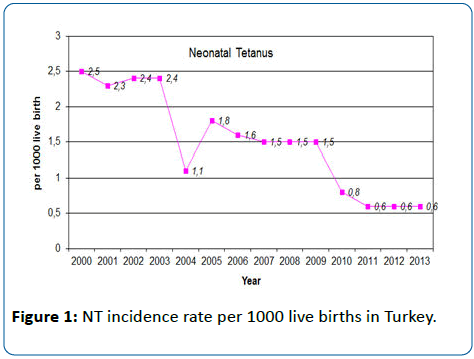Neonatal Tetanus: Last Situation in Turkey
Dikici B, Kara IH
DOI10.21767/2573-0282.100002
1Departments of Pediatrics, Duzce University, Turkey
2Departments of Family Medicine, Duzce University, Turkey
- *Corresponding Author:
- Dikici B
Departments of Pediatrics, Duzce University, Turkey
Tel: 0163-7222688
E-mail: bdikici@hotmail.com
Received date: November 27, 2015 Accepted date: February 07, 2016 Published date: February 12, 2016
Citation: Dikici B, Kara IH. Neonatal Tetanus: Last Situation in Turkey. J Pediatric Infect Dis. 2015, 1:2. doi: 10.21767/2573-0282.100002
Abstract
It’s a pleasure for us to take your offer to prepare a brief report on neonatal tetanus (NT). Regarding our study entitled "Neonatal tetanus in Turkey; what has changed in the last decade?" had been published in 2008 [1]; we want to emphasize the level reached in the field of neonatal tetanus under the light of the knowledge gathered in recent ten years, and we want to share with your journal.
Keywords
Neonatal tetanus; Turkey; Children
Introduction
It’s a pleasure for us to take your offer to prepare a brief report on neonatal tetanus (NT). Regarding our study entitled "Neonatal tetanus in Turkey; what has changed in the last decade?" had been published in 2008 [1]; we want to emphasize the level reached in the field of neonatal tetanus under the light of the knowledge gathered in recent ten years, and we want to share with your journal.
NT is a major public health problem in the developing world. Maternal and neonatal tetanus (MNT) have been among the most common lethal consequences of unclean deliveries and umbilical cord care practices. When tetanus develops, mortality rates are extremely high, especially when appropriate medical care is not available. This happens despite the fact that MNT deaths can be easily prevented by hygienic delivery and cord care practices, and/or by immunizing mothers with tetanus vaccine that is cheap and very efficacious. In 1988, WHO estimated that 787,000 new borns died of NT. Thus, in the late 1980s, the estimated annual global NT mortality rate was approximately 6.7 NT deaths per 1000 live births - clearly a substantial public health problem. In 1999, when progress towards the attainment of the global elimination goal was reviewed by UNICEF, WHO and UNFPA, the Initiative was re-constituted and elimination of maternal tetanus was added to the goal with a 2005 target date, which was later shifted to 2015.WHO estimates that in 2013, 49,000 newborns died from NT, a 94% reduction from the situation in the late 1980s [2].
The World Health Assembly first called for elimination of neonatal tetanus in 1989. In 1999, the goal was expanded to include elimination of the maternal tetanus. At that time, there were 57 countries that had still not eliminated MNT. As of August 2015, 38 of these countries had achieved MNT elimination leaving 21 countries that still have not eliminated the disease. Through the joint efforts of partners much progress has been made between 1999 and August 2015: MNT elimination in a country is defined as neonatal tetanus rate of less than one case of neonatal tetanus per 1000 live births in every district of the country [3].
Tetanus can be prevented through vaccination, which is highly safe and efficacious [4]. Routine childhood vaccination began in Turkey in 1989. The number of cases reported was significantly decreased after initiation of vaccination program in pregnant women and children. We shared the current situation in Turkey in the NT; two large series of pediatric patients and studies have been published in 9 year intervals in 1997 and 2006 [1,5]. In the same period, "non-Pediatric Patients with NT" was common in the study in Turkey [6]. Now, there are no new publications except for minor case studies in Turkey. According to statistics of World Health Organization in Turkey and; NT incidence rate per 1000 live births has successfully reduced below 1, since 2010 (Figure 1) [7].
Socio-economic development in the last decade significantly improved living conditions and wealth as well as health indicators in Turkey. Maternal and child health care services and immunization programmes, ensuring higher accessibility to health care services also played role in improvements in health status. The rate of full vaccination coverage increased from 78% in 2002 to 97% in 2011. The number of per capita visits to health care facilities was 3.2 in 2002, it increased to 8.2 in 2011. Similarly, per capita hospital visits increased from 2.0 in 2002 to 4.9 in 2011 [8].
Conclusion
As a conclusion, an important development was achieved on NT in Turkey since the beginning of tetanus vaccination program27 years ago. The goal of less than one case in every 1000 live births which was determined by WHO in 1999 was reached 5 years ago in 2010 in Turkey.
References
- Dikici B, Uzun H, Yilmaz-Keskin E, et al. (2008) Neonatal tetanus in Turkey; what has changed in the last decade? BMC Infect Dis 8: 112.
- World Health Organization (2015) Maternal and Neonatal Tetanus (MNT) elimination 11:44 CEST.
- https://www.unicef.org/health/index_43509.html.
- Gençer MZ, Alicioglu F, Artica S, Arica V (2015) Socio-Demographic Characteristics of Parents with Children between 24–72 Months of Age and Their Knowledge and Attitudes about Self-Paid Vaccines: Comparison of East vs. West. Konuralp Medical Journal 3: 141-145.
- Neonatal tetanus in Turkey; what has changed in the last decade?
- Hosoglu S, Ayaz C, Geyik MF, Yusuf Yagmur, Omer FarukKokoglu, et al. (1997) A continuing problem of tetanus in the southeast of Turkey. ClinMicrobiol Infect 3: 690-692.
- https://apps.who.int/gho/data/view.main.ghe300-TUR?lang=en.
- https://www.who.int/countryfocus/cooperation_strategy/ccsbrief_tur_en.pdf.
Open Access Journals
- Aquaculture & Veterinary Science
- Chemistry & Chemical Sciences
- Clinical Sciences
- Engineering
- General Science
- Genetics & Molecular Biology
- Health Care & Nursing
- Immunology & Microbiology
- Materials Science
- Mathematics & Physics
- Medical Sciences
- Neurology & Psychiatry
- Oncology & Cancer Science
- Pharmaceutical Sciences

